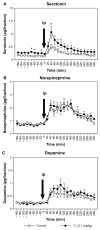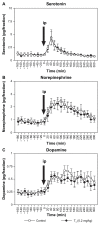Effect of triiodothyronine (T(3)) augmentation of acute milnacipran administration on monoamine levels: an in vivo microdialysis study in rats
- PMID: 23139627
- PMCID: PMC3489053
- DOI: 10.2147/NDT.S36906
Effect of triiodothyronine (T(3)) augmentation of acute milnacipran administration on monoamine levels: an in vivo microdialysis study in rats
Abstract
Background: Up to 30% of depressed patients are partially or totally resistant to antidepressant therapy. The administration of triiodothyronine (T(3)) to antidepressant nonresponders can be an effective augmentation strategy, although the mechanism is not fully understood.
Methods: In vivo microdialysis was used to examine the effect of T(3) augmentation of the antidepressant, milnacipran. Basal extracellular serotonin, norepinephrine, and dopamine levels were measured before and after acute milnacipran administration in the medial prefrontal cortex and amygdala of rats which had received subchronic (7 days) T(3) treatment or control saline.
Results: Subchronic administration of T(3) at 0.1 mg/kg significantly increased basal extracellular levels of serotonin in the medial prefrontal cortex, but not in the amygdala. In contrast, subchronic administration of T(3) at 0.2 mg/kg did not alter basal extracellular serotonin levels in the medial prefrontal cortex. Basal extracellular levels of norepinephrine and dopamine were not modified by either dose of T(3) in either region. Acute administration of milnacipran, a serotonin-norepinephrine reuptake inhibitor, to control animals resulted in a significant increase of extracellular levels of serotonin, norepinephrine, and dopamine. When administered to animals treated subchronically with T(3) at 0.1 mg/kg, milnacipran produced an additional increase in extracellular serotonin levels but not in levels of norepinephrine or dopamine in the medial prefrontal cortex of rats.
Conclusion: These results suggest that the mechanism of the augmentation effect of milnacipran by T(3) administration occurs via enhancement of serotonergic neurotransmission, but not through noradrenergic or dopaminergic neurotransmission.
Keywords: depression; in vivo microdialysis; milnacipran; monoamines; triiodothyronine.
Figures



Similar articles
-
Subchronic milnacipran treatment increases basal extracellular noradrenaline concentrations in the medial prefrontal cortex of rats.Eur J Pharmacol. 2005 Sep 27;520(1-3):37-42. doi: 10.1016/j.ejphar.2005.08.004. Eur J Pharmacol. 2005. PMID: 16153636
-
Effect of milnacipran on extracellular monoamine concentrations in the medial prefrontal cortex of rats pre-treated with lithium.Eur J Pharmacol. 2005 Jun 15;516(3):219-26. doi: 10.1016/j.ejphar.2005.04.038. Eur J Pharmacol. 2005. PMID: 15963494
-
A combination of mirtazapine and milnacipran augments the extracellular levels of monoamines in the rat brain.Neuropharmacology. 2012 Jun;62(7):2278-87. doi: 10.1016/j.neuropharm.2012.01.024. Epub 2012 Feb 4. Neuropharmacology. 2012. PMID: 22342987
-
Bupropion: a review of its mechanism of antidepressant activity.J Clin Psychiatry. 1995 Sep;56(9):395-401. J Clin Psychiatry. 1995. PMID: 7665537 Review.
-
Milnacipran.2019 May 20. LiverTox: Clinical and Research Information on Drug-Induced Liver Injury [Internet]. Bethesda (MD): National Institute of Diabetes and Digestive and Kidney Diseases; 2012–. 2019 May 20. LiverTox: Clinical and Research Information on Drug-Induced Liver Injury [Internet]. Bethesda (MD): National Institute of Diabetes and Digestive and Kidney Diseases; 2012–. PMID: 31643293 Free Books & Documents. Review.
References
-
- Murray CJL, Lopez AD. The Global Burden of Disease: A Comprehensive Assessment of Mortality and Disability from Disease, Injuries, and Risk Factors in 1990 and Projected to 2020. Cambridge, MA: Harvard University Press; 1996. p. 1.
-
- Fava M. Diagnosis and definition of treatment-resistant depression. Biol Psychiatry. 2003;53:649–659. - PubMed
-
- Joffe RT, Levitt AJ, Sokolov ST. Augmentation strategies. J Clin Psychiatry. 1996;57:25–31. - PubMed
-
- Connolly KR, Thase ME. If at first you don’t succeed: a review of the evidence for antidepressant augmentation, combination and switching strategies. Drugs. 2011;71:43–64. - PubMed
-
- Cooper-Kazaz R, Lerer B. Efficacy and safety of triiodothyronine supplement in patients with major depressive disorder treated with specific serotonin reuptake inhibitors. Int J Neuropsychopharmacol. 2008;11:685–699. - PubMed
LinkOut - more resources
Full Text Sources

